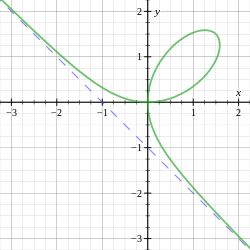Clifford's theorem on special divisors
In mathematics, Clifford's theorem on special divisors is a result of W. K. Clifford (1878) on algebraic curves, showing the constraints on special linear systems on a curve C.
Statement
If D is a divisor on C, then D is (abstractly) a formal sum of points P on C (with integer coefficients), and in this application a set of constraints to be applied to functions on C (if C is a Riemann surface, these are meromorphic functions, and in general lie in the function field of C). Functions in this sense have a divisor of zeros and poles, counted with multiplicity; a divisor D is here of interest as a set of constraints on functions, insisting that poles at given points are only as bad as the positive coefficients in D indicate, and that zeros at points in D with a negative coefficient have at least that multiplicity. The dimension of the vector space
- L(D)
of such functions is finite, and denoted ℓ(D). Conventionally the linear system of divisors attached to D is then attributed dimension r(D) = ℓ(D) − 1, which is the dimension of the projective space parametrizing it.
The other significant invariant of D is its degree, d, which is the sum of all its coefficients.
A divisor is called special if ℓ(K − D) > 0, where K is the canonical divisor.[1]
In this notation, Clifford's theorem is the statement that for an effective special divisor D,
- ℓ(D) − 1 ≤ d/2,
together with the information that the case of equality here is only for D zero or canonical, or C a hyperelliptic curve and D linearly equivalent to an integral multiple of a hyperelliptic divisor.
The Clifford index of C is then defined as the minimum value of the d − 2r(D), taken over all special divisors (that are not canonical or trivial). Clifford's theorem is then the statement that this is non-negative. The Clifford index for a generic curve of genus g is the floor function of
The Clifford index measures how far the curve is from being hyperelliptic. It may be thought of as a refinement of the gonality: in many cases the Clifford index is equal to the gonality minus 2.[2]
Green's Conjecture
A conjecture of Mark Green states that the Clifford index for a curve over the complex numbers that is not hyperelliptic should be determined by the extent to which C as canonical curve has linear syzygies. In detail, the invariant a(C) is determined by the minimal free resolution of the homogeneous coordinate ring of C in its canonical embedding, as the largest index i for which the graded Betti number βi, i + 2 is zero. Green and Lazarsfeld showed that a(C) + 1 is a lower bound for the Clifford index, and Green's conjecture is that equality always holds. There are numerous partial results.[3]
Claire Voisin was awarded the Ruth Lyttle Satter Prize in Mathematics for her solution of the generic case of Green's conjecture in two papers.[4][5] The case of Green's conjecture for generic curves had attracted a huge amount of effort by algebraic geometers over twenty years before finally being laid to rest by Voisin.[6] The conjecture for arbitrary curves remains open.
Notes
- ↑ Hartshorne p.296
- ↑ Eisenbud (2005) p.178
- ↑ Eisenbud (2005) pp. 183-4.
- ↑ Green's canonical syzygy conjecture for generic curves of odd genus - Claire Voisin
- ↑ Green’s generic syzygy conjecture for curves of even genus lying on a K3 surface - Claire Voisin
- ↑ Satter Prize
References
- E. Arbarello; M. Cornalba; P.A. Griffiths; J. Harris (1985). Geometry of Algebraic Curves Volume I. Grundlehren de mathematischen Wisenschaften 267. ISBN 0-387-90997-4.
- Clifford, W. K. (1878), "On the Classification of Loci", Philosophical Transactions of the Royal Society of London, The Royal Society, 169: 663–681, doi:10.1098/rstl.1878.0020, ISSN 0080-4614, JSTOR 109316
- Eisenbud, David (2005). The Geometry of Syzygies. A second course in commutative algebra and algebraic geometry. Graduate Texts in Mathematics. 229. New York, NY: Springer-Verlag. ISBN 0-387-22215-4. Zbl 1066.14001.
- William Fulton (1974). Algebraic Curves. Mathematics Lecture Note Series. W.A. Benjamin. p. 212. ISBN 0-8053-3080-1.
- P.A. Griffiths; J. Harris (1994). Principles of Algebraic Geometry. Wiley Classics Library. Wiley Interscience. p. 251. ISBN 0-471-05059-8.
- Robin Hartshorne (1977). Algebraic Geometry. Graduate Texts in Mathematics. 52. ISBN 0-387-90244-9.
External links
- Iskovskikh, V.A. (2001) [1994], "Clifford theorem", in Hazewinkel, Michiel, Encyclopedia of Mathematics, Springer Science+Business Media B.V. / Kluwer Academic Publishers, ISBN 978-1-55608-010-4
